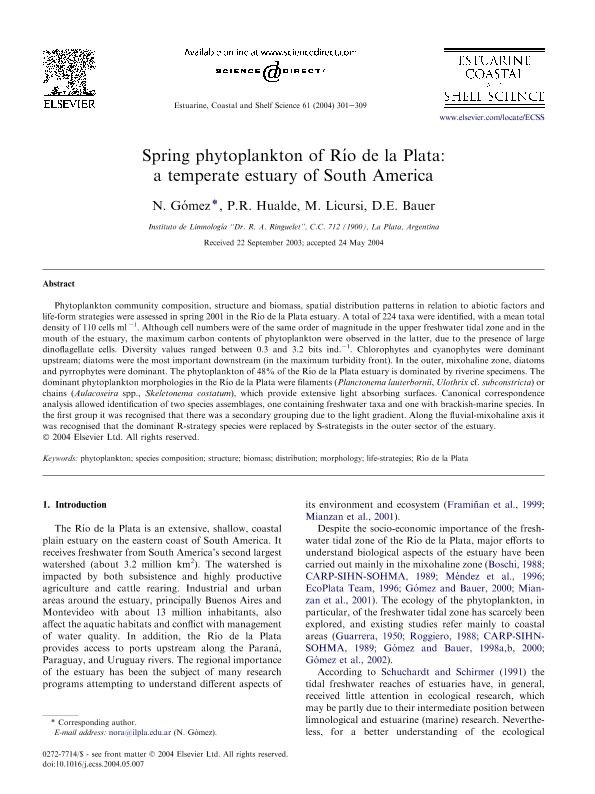Artículo
Spring phytoplankton of Río de la Plata: a temperate estuary of South America
Fecha de publicación:
09/2004
Editorial:
Elsevier
Revista:
Estuarine, Coastal and Shelf Science
ISSN:
0272-7714
Idioma:
Inglés
Tipo de recurso:
Artículo publicado
Clasificación temática:
Resumen
Phytoplankton community composition, structure and biomass, spatial distribution patterns in relation to abiotic factors and life-form strategies were assessed in spring 2001 in the Río de la Plata estuary. 224 taxa were identified, with a mean total density of 110 cell ml-1. Although cell numbers were of the same order of magnitude in the upper freshwater tidal zone and in the mouth of the estuary, the maximum carbon contents of phytoplankton were observed in the latter, due to the presence of large dinoflagellate cells. Diversity values ranged between 0.3 and 3.2 bits.ind.-1 Chlorophytes and cyanophytes were dominant upstream; diatoms were the most important downstream (in the maximum turbidity front). In the outer, mixohaline zone, diatoms and pyrrophytes were dominant. The phytoplankton of 48% of the Río de la Plata estuary is dominated by riverine specimens. The dominant phytoplankton morphologies in the Río de la Plata were filaments (Planctonema lauterbornii, Ulothrix cf. subconstricta) or chains (Aulacoseira spp., Skeletonema costatum), which provide extensive light absorbing surfaces. Canonical correspondence analysis allowed identification of two species assemblages, one containing freshwater taxa and one with brackish-marine species. In the first group it was recognised that there was a secondary grouping due to the light gradient. Along the fluvial-mixohaline axis it was recognised that the dominant R-strategy species were replaced by S-strategists in the outer sector of the estuary.
Palabras clave:
Phytoplankton
,
Species Composition
,
Structure
,
Biomass
Archivos asociados
Licencia
Identificadores
Colecciones
Articulos(ILPLA)
Articulos de INST.DE LIMNOLOGIA "DR. RAUL A. RINGUELET"
Articulos de INST.DE LIMNOLOGIA "DR. RAUL A. RINGUELET"
Citación
Licursi, Magdalena; Bauer, Delia Elena; Hualde, Paula R.; Gomez, Nora; Spring phytoplankton of Río de la Plata: a temperate estuary of South America; Elsevier; Estuarine, Coastal and Shelf Science; 61; 2; 9-2004; 301-309
Compartir
Altmétricas




